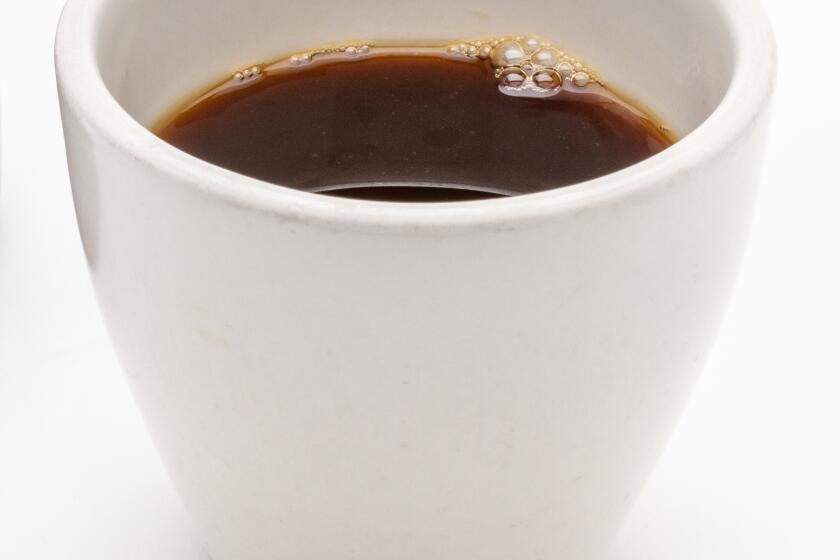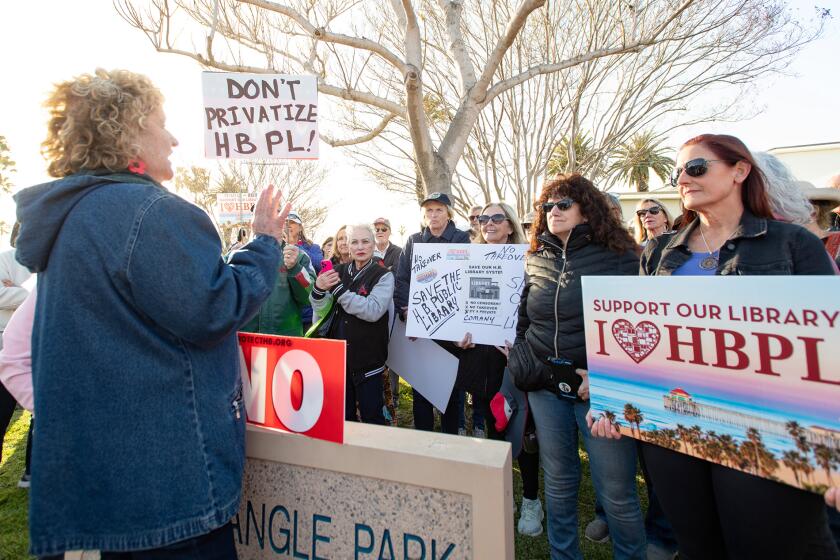In the Pipeline: Hidden monument to the people
Since the New Year starts off with my 300th In The Pipeline column, I thought we’d go back to the beginning for an update.
Column No. 1 involved a mysterious landmark, a black, granite tombstone at Springdale Street and Warner Avenue, in the bushes behind the Arco station. Its text reads: “In recognition of Lloyd Wright’s 94-foot-high sign tower that was to have been erected on this spot. Its defeat is symbolic of the democratic process in which we live. The people did not wish this sign tower to be erected as they felt it was not needed and would blight their community. Their wishes were heard and adhered to by the developer, Stanley Fann. — 1970”
I’d seen it for years and decided to kick things off by trying to figure out what it all meant. As you might recall, my investigation brought me, luckily to Los Angeles-based multi-media artist (and architect aficionado) Patrick Tierney. Years earlier he had tracked down the center’s developer, Stanley Fann, and learned all about the story of how Frank Lloyd Wright Jr., son of the famed American architect, came to Huntington Beach back in the late 1960s to design the Westfair Shopping Center (and the adjoining gas station).
As for the tower, Tierney explained to me in 2007 that locals vehemently protested the idea of a 94-foot behemoth in their neighborhood, thwarting the plans of the great architect. The tombstone was placed, in Tierney’s words, as “A 500-pound, permanent proclamation of victory of the People.”
I’ve always wondered what the tower would have looked like. The developer, Stanley Fann told me back then that it was designed to look like an oil derrick, in honor of the city’s “crude” history. Well, thanks to Tierney, now I know what it would have looked like, as do you, because he has shared Wright’s original concept sketch (which he purchased from Fann).
I find it quite bizarre, less like an oil derrick and more like some sort of futuristic transmission tower. But of course I wanted Tierney’s learned opinion.
He said, “When I saw the rendering of the tower I failed to find any resemblance to an oil derrick. After some reflection, I surmised that the public was so fed up with the perceived blight of the oil derricks that once riddled the Huntington Beach landscape that the word ‘oil well’ became the locals synonymous expression for any following threats of intrusion being proposed on the same magnitude as an oil derrick. I liken Wright’s tower to an origami-like floral form, comprised of four signboard petals and stylized stamen. It’s a poetic coincidence that the then onsite Sav-On Drugstore’s ‘Yin Yang-inspired corporate logo was branded on one of those petals. Additionally, the father and son Wright’s were very much fascinated with and influenced by Orientalism.”
As far as Wright’s reaction to the rejection of the tower, Tierney shared, “Unlike other public phallic obelisks, towers and totems in history, I feel that to the arrogant and emotional Wright, all his trademark pylon markers were highly personal expressions, so the rejection of it impacted him as symbolic castration of his potency and prowess. The Westfair developer Stanley Fann, bears this out when he shared that Wright ‘bawled like a baby’ when he received the bad news.”
And as to the importance today of Westfair, Tierney explained to me in depth:
“In historic terms I feel that the Westfair Shopping Center and service station alone merits at very least a footnote in texts on Lloyd Wright’s work in which his temperament is addressed.
“Certainly the Westfair is ripe for inclusion in popular coffee table books on roadside vernacular, whether or not the sign tower was erected because of the inevitability that the public uprising would have preceded the controversy over the sign tower in either scenario. Of course, the actual outcome is preferable as the tremendously sexy narrative of the rejection of an architectural Titan.
“With more exposure, the service station element of the tower story alone could bring to it the same great interest that Wright fans have shown with the service station that Lloyd Wright’s father designed in Cloquet, Minnesota (his sole service station commission as well) has drawn to that project.
“In both cases the Wright’s service stations are novel among their works, not solely for them being one of a kind, but for the Wright’s brave willingness to see beyond the public’s popular perception of the service station as being beneath an architect’s dignity to design; designs which the Wrights were compelled to put forward by their largely unrealized ideological interests which embodied in part a Socialistic vision of creating affordable, utopian communities for the working class.”
So there you have it. What the infamous tower would have looked like, along with erudite commentary from a true Wright scholar.
Personally, I do wish the tower had been built. Just look at it. Visible for miles, it would have been a spectacular spike in the landscape and perhaps our city’s greatest conversation piece. Eric Lloyd Wright, the architect’s son, who has his own architectural firm in Malibu, apprenticed for eight years with his grandfather, Frank Lloyd Wright, as well as working with his father on Westfair. He told me in ’07 that he wishes it had been built, too.
Forget the aesthetics for a moment. Just think of the tourism, which has become, in many ways, Huntington Beach’s most valuable, visible product. This thing would have been a magnet for many, especially students of architecture, a fact which probably would have saved it today – that it might actually have generated a few dollars. Then again, I think I’d like it simply because I tend to enjoy a good spectacle.
On that note, here’s to a few good spectacles in ’13. Happy New Year!
CHRIS EPTING is the author of 19 books, including the new “Baseball in Orange County,” from Arcadia Publishing. You can chat with him on Twitter: @chrisepting or follow his column at https://www.facebook.com/hbindependent.
All the latest on Orange County from Orange County.
Get our free TimesOC newsletter.
You may occasionally receive promotional content from the Daily Pilot.



